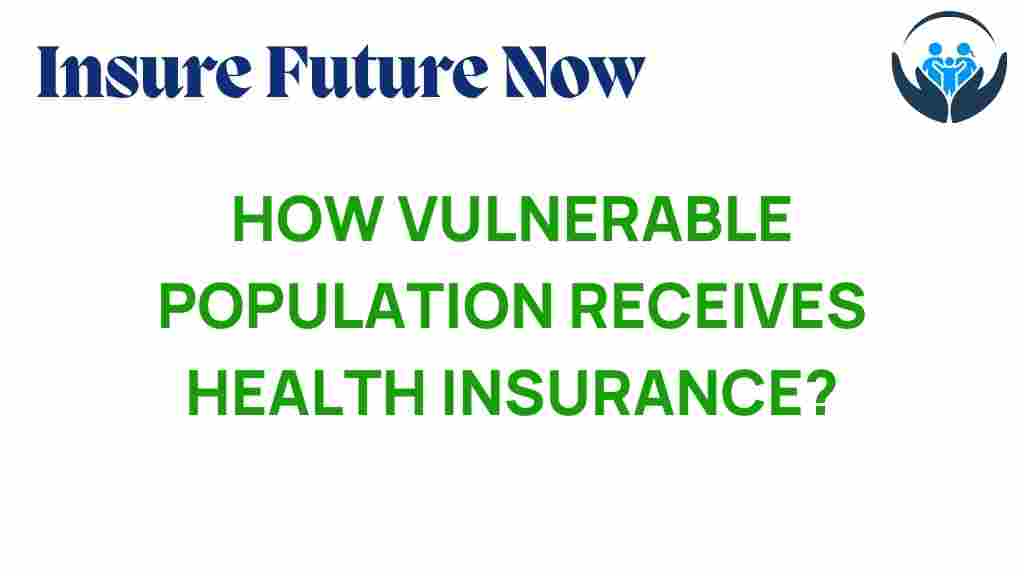Unveiling the Secrets: How Vulnerable Populations Secure Health Insurance
Access to health insurance is a fundamental aspect of achieving health equity, particularly for vulnerable populations. These groups often face significant challenges in obtaining adequate health coverage, which can lead to healthcare disparities and poor health outcomes. In this article, we will explore the various pathways available for vulnerable populations to secure health insurance, the role of assistance programs, and the importance of social safety nets in promoting access and equity in healthcare.
Understanding Vulnerable Populations
Vulnerable populations include individuals and groups who experience a higher risk of poor health outcomes due to socioeconomic factors, discrimination, or lack of access to healthcare services. These may include:
- Low-income families
- Unemployed individuals
- Racial and ethnic minorities
- People with disabilities
- Senior citizens
- Undocumented immigrants
Understanding the unique challenges faced by these groups is crucial in addressing their health insurance needs and ensuring equitable access to healthcare.
The Importance of Health Insurance for Vulnerable Populations
Health insurance plays a vital role in providing vulnerable populations with access to healthcare services. It helps to:
- Reduce out-of-pocket costs for medical services
- Provide preventive care and early intervention
- Enhance access to specialists and necessary treatments
- Protect against financial hardship due to medical expenses
Without health insurance, vulnerable populations are more likely to experience healthcare disparities, leading to worse health outcomes and increased mortality rates.
How Vulnerable Populations Secure Health Insurance
Securing health insurance can be a daunting task for vulnerable populations, but several pathways and policies exist to facilitate access. Below are key steps and resources that can assist these groups in obtaining coverage.
1. Understanding Available Health Insurance Options
Vulnerable populations should familiarize themselves with the various health insurance options available, including:
- Medicaid: A state and federal program that provides health coverage to low-income individuals and families.
- Medicare: A federal program primarily for individuals aged 65 and older, but also available to younger individuals with disabilities.
- Marketplace Insurance: Plans offered through the Health Insurance Marketplace, which may include subsidies for those with low to moderate incomes.
Each option has specific eligibility criteria and benefits, which should be carefully evaluated.
2. Utilizing Assistance Programs
Various assistance programs exist to help vulnerable populations navigate the complexities of health insurance and healthcare access. These programs may include:
- Community Health Centers: These centers provide comprehensive healthcare services regardless of a patient’s ability to pay.
- State Health Insurance Assistance Programs (SHIPs): These programs offer personalized assistance to help individuals understand their health insurance options.
- Nonprofit Organizations: Many organizations provide resources, advocacy, and support for vulnerable populations seeking health coverage.
Engaging with these programs can significantly enhance access to healthcare services.
Understanding health insurance enrollment periods is crucial for vulnerable populations. Key enrollment periods include:
- Open Enrollment Period (OEP): A designated time each year when individuals can enroll in or change their health insurance plans.
- Special Enrollment Periods (SEPs): Opportunities to enroll outside of the OEP due to qualifying life events, such as loss of employment or moving to a new state.
Staying informed about these periods ensures that vulnerable populations do not miss out on critical coverage opportunities.
4. Seeking Help from Social Safety Nets
Social safety nets play a crucial role in supporting vulnerable populations in accessing health insurance. These programs may include:
- Temporary Assistance for Needy Families (TANF): Provides financial assistance and support services to low-income families.
- Supplemental Nutrition Assistance Program (SNAP): Offers food assistance, which can help free up resources for healthcare expenses.
- Housing Assistance: Programs that help provide stable housing, reducing the stressors that can impact health.
Utilizing these resources can mitigate some of the barriers that vulnerable populations face when seeking health insurance.
Troubleshooting Tips for Securing Health Insurance
Despite the pathways available, vulnerable populations may encounter challenges when trying to secure health insurance. Here are some troubleshooting tips to help overcome common barriers:
1. Understanding Eligibility Requirements
Before applying for health insurance, it is essential to understand the eligibility requirements for each program. This can be a complex process, but resources are available such as:
- State Medicaid and CHIP agencies
- Healthcare.gov for Marketplace plans
- Local community organizations that provide assistance
2. Keeping Documentation Organized
Having the necessary documentation ready can streamline the application process. Important documents include:
- Proof of income (pay stubs, tax returns)
- Identification (driver’s license, Social Security card)
- Proof of residence (utility bills, lease agreements)
Health insurance navigators are trained professionals who can assist individuals in understanding their options and completing applications. They are available through:
- Community organizations
- Health departments
- Nonprofit organizations focused on healthcare access
Don’t hesitate to reach out for help; it can make a significant difference in securing coverage.
4. Advocating for Policy Changes
Vulnerable populations can benefit from advocating for policy changes that enhance access to health insurance. This can involve:
- Joining advocacy groups focused on healthcare equity
- Participating in community forums to raise awareness about healthcare disparities
- Contacting local representatives to discuss the importance of accessible health insurance
Collective advocacy can lead to meaningful changes in health policy that benefit vulnerable populations.
Conclusion
Securing health insurance is a critical step for vulnerable populations in achieving health equity and accessing necessary healthcare services. Understanding the available options, utilizing assistance programs, navigating enrollment periods, and leveraging social safety nets are essential strategies for overcoming barriers to coverage. By following these steps and seeking support, vulnerable populations can improve their health outcomes and reduce healthcare disparities. Together, we can work towards a future where access to health insurance is equitable for all.
For more information on health insurance options, visit Healthcare.gov. To learn more about community assistance programs, check out Local Community Organizations.
This article is in the category Coverage and created by InsureFutureNow Team
